HYPERSPECTRAL DATA
PROCESSING
�
HYPERSPECTRAL DATA
PROCESSING
Algorithm Design and Analysis
Chein-I Chang
University of Maryland, Baltimore County (UMBC), Maryland, USA
�
Copyright # 2013 by John Wiley & Sons, Inc. All rights reserved
Published by John Wiley & Sons, Inc., Hoboken, NJ
Published simultaneously in Canada
No part of this publication may be reproduced, stored in a retrieval system, or transmitted in any form or by any means,
electronic, mechanical, photocopying, recording, scanning, or otherwise, except as permitted under Section 107 or 108 of
the 1976 United States Copyright Act, without either the prior written permission of the Publisher, or authorization
through payment of the appropriate per-copy fee to the Copyright Clearance Center, Inc., 222 Rosewood Drive, Danvers,
MA 01923, (978) 750-8400, fax (978) 750-4470, or on the web at www.copyright.com. Requests to the Publisher for
permission should be addressed to the Permissions Department, John Wiley & Sons, Inc., 111 River Street, Hoboken, NJ
07030, (201) 748-6011, fax (201) 748-6008, or online at http://www.wiley.com/go/permission.
Limit of Liability/Disclaimer of Warranty: While the publisher and author have used their best efforts in preparing this book,
they make no representations or warranties with respect to the accuracy or completeness of the contents of this book and
specifically disclaim any implied warranties of merchantability or fitness for a particular purpose. No warranty may be
created or extended by sales representatives or written sales materials. The advice and strategies contained herein may not
be suitable for your situation. You should consult with a professional where appropriate. Neither the publisher nor author
shall be liable for any loss of profit or any other commercial damages, including but not limited to special, incidental,
consequential, or other damages.
For general information on our other products and services or for technical support, please contact our Customer Care
Department within the United States at (800) 762-2974, outside the United States at (317) 572-3993 or fax (317) 572-4002.
Wiley also publishes its books in a variety of electronic formats. Some content that appears in print may not be available in
electronic formats. For more information about Wiley products, visit our web site at www.wiley.com.
Library of Congress Cataloging-in-Publication Data:
Chang, Chein-I.
Hyperspectral data processing : algorithm design and analysis / Chein-I Chang.
p. cm.
Includes bibliographical references and index.
ISBN 978-0-471-69056-6 (hardback)
1.
Image processing–Digital techniques. 2. Spectroscopic imaging. 3. Signal processing.
I. Chang, Chein-I.
Hyperspectral imaging. II. Title.
TA1637.C4776 2012
621.39’94–dc23
Printed in the United States of America
10 9 8 7 6 5 4 3 2 1
2011043896
�
This book is dedicated to members of my family, specifically
my mother who provided me with her timeless support
and encouragement during the course of preparing
this book. It is also dedicated to all of my students
who have contributed to this book.
�
Contents
PREFACE
xxiii
1 OVERVIEW AND INTRODUCTION
1.1
1.2
1.3
1.4
1.5
1.6
1.7
1.8
Overview
Issues of Multispectral and Hyperspectral Imageries
Divergence of Hyperspectral Imagery from Multispectral Imagery
1.3.1
Misconception: Hyperspectral Imaging is a Natural Extension
of Multispectral Imaging
Pigeon-Hole Principle: Natural Interpretation of Hyperspectral Imaging
1.3.2
Scope of This Book
Book’s Organization
1.5.1
1.5.2
1.5.3
1.5.4
1.5.5
1.5.6
1.5.7
1.5.8
Part I: Preliminaries
Part II: Endmember Extraction
Part III: Supervised Linear Hyperspectral Mixture Analysis
Part IV: Unsupervised Hyperspectral Analysis
Part V: Hyperspectral Information Compression
Part VI: Hyperspectral Signal Coding
Part VII: Hyperspectral Signal Feature Characterization
Applications
1.5.8.1
1.5.8.2
Chapter 30: Applications of Target Detection
Chapter 31: Nonlinear Dimensionality Expansion to Multispectral
Imagery
Chapter 32: Multispectral Magnetic Resonance Imaging
1.5.8.3
Laboratory Data to be Used in This Book
1.6.1
Laboratory Data
1.6.2
Cuprite Data
1.6.3
NIST/EPA Gas-Phase Infrared Database
Real Hyperspectral Images to be Used in this Book
1.7.1
AVIRIS Data
1.7.1.1
1.7.1.2
HYDICE Data
Cuprite Data
Purdue’s Indiana Indian Pine Test Site
1.7.2
Notations and Terminologies to be Used in this Book
1
2
3
4
4
5
7
10
10
12
13
13
15
16
17
17
17
18
19
19
19
19
19
20
20
21
25
26
29
vii
�
viii
I: PRELIMINARIES
2 FUNDAMENTALS OF SUBSAMPLE AND MIXED SAMPLE ANALYSES
Contents
31
33
33
35
35
38
39
41
43
45
45
46
48
54
54
56
57
57
58
59
60
63
63
65
67
69
72
72
73
75
77
78
79
79
80
83
84
87
91
95
99
2.1
2.2
Introduction
Subsample Analysis
2.2.1
2.2.2
2.3 Mixed Sample Analysis
Pure-Sample Target Detection
Subsample Target Detection
2.2.2.1
2.2.2.2
Subsample Target Detection: Constrained Energy Minimization (CEM)
Adaptive Matched Detector (AMD)
Adaptive Subspace Detector (ASD)
2.2.3
2.3.1
2.3.2
Fisher’s Linear Discriminant Analysis (FLDA)
Support Vector Machines (SVM)
Classification with Hard Decisions
2.3.1.1
2.3.1.2
Classification with Soft Decisions
2.3.2.1
2.3.2.2
Orthogonal Subspace Projection (OSP)
Target-Constrained Interference-Minimized
Filter (TCIMF)
2.4
2.5
Kernel-Based Classification
2.4.1
2.4.2
2.4.3
Conclusions
Kernel Trick Used in Kernel-Based Methods
Kernel-Based Fisher’s Linear Discriminant Analysis (KFLDA)
Kernel Support Vector Machine (K-SVM)
3 THREE-DIMENSIONAL RECEIVER OPERATING CHARACTERISTICS (3D ROC)
ANALYSIS
3.1
3.2
3.3
3.4
3.5
3.6
3.7
Introduction
Neyman–Pearson Detection Problem Formulation
ROC Analysis
3D ROC Analysis
Real Data-Based ROC Analysis
3.5.1
3.5.2
3.5.3
3.5.4
How to Generate ROC Curves from Real Data
How to Generate Gaussian-Fitted ROC Curves
How to Generate 3D ROC Curves
How to Generate 3D ROC Curves for Multiple Signal Detection and
Classification
Examples
3.6.1
3.6.2
3.6.3
3.6.4
Conclusions
Hyperspectral Target Detection
Linear Hyperspectral Mixture Analysis
Hyperspectral Imaging
3.6.1.1
3.6.1.2
Magnetic Resonance (MR) Breast Imaging
Breast Tumor Detection
3.6.2.1
3.6.2.2
Brain Tissue Classification
Chemical/Biological Agent Detection
Biometric Recognition
�
Contents
4 DESIGN OF SYNTHETIC IMAGE EXPERIMENTS
4.1
4.2
4.3
4.4
Introduction
Simulation of Targets of Interest
4.2.1
4.2.2
Six Scenarios of Synthetic Images
4.3.1
4.3.2
Simulation of Synthetic Subsample Targets
Simulation of Synthetic Mixed-Sample Targets
Panel Simulations
Three Scenarios for Target Implantation (TI)
4.3.2.1
4.3.2.2
4.3.2.3
Scenario TI1 (Clean Panels Implanted into Clean Background)
Scenario TI2 (Clean Panels Implanted into Noisy Background)
Scenario TI3 (Gaussian Noise Added to Clean Panels
Implanted into Clean Background)
4.3.3
Three Scenarios for Target Embeddedness (TE)
4.3.3.1
4.3.3.2
4.3.3.3
Scenario TE1 (Clean Panels Embedded in Clean Background)
Scenario TE2 (Clean Panels Embedded in Noisy Background)
Scenario TE3 (Gaussian Noise Added to Clean Panels
Embedded in Background)
Applications
4.4.1
4.4.2
4.4.3
Endmember Extraction
Linear Spectral Mixture Analysis (LSMA)
4.4.2.1
4.4.2.2
Target Detection
4.4.3.1
4.4.3.2
Mixed Pixel Classification
Mixed Pixel Quantification
Subpixel Target Detection
Anomaly Detection
4.5
Conclusions
5 VIRTUAL DIMENSIONALITY OF HYPERSPECTRAL DATA
5.1
5.2
5.3
Introduction
Reinterpretation of VD
VD Determined by Data Characterization-Driven Criteria
5.3.1
Eigenvalue Distribution-Based Criteria
5.3.1.1
5.3.1.2
Thresholding Energy Percentage
Thresholding Difference between Normalized Correlation
Eigenvalues and Normalized Covariance Eigenvalues
Finding First Sudden Drop in the Normalized Eigenvalue
Distribution
5.3.1.3
5.3.2
5.3.3
5.3.4
5.3.5
Singular Value Decomposition (SVD)
Principal Components Analysis (PCA)
Eigen-Based Component Analysis Criteria
5.3.2.1
5.3.2.2
Factor Analysis: Malinowski’s Error Theory
Information Theoretic Criteria (ITC)
5.3.4.1
5.3.4.2
Gershgorin Radius-Based Methods
5.3.5.1
5.3.5.2
AIC
MDL
Thresholding Gershgorin Radii
Thresholding Difference Gershgorin Radii between RL�L and KL�L
ix
101
102
103
103
104
104
104
106
106
107
108
108
109
109
110
112
112
113
114
114
114
114
122
123
124
124
126
126
127
127
128
128
128
128
129
129
130
131
131
131
134
134
�
x
Contents
HFC Method
Discussions on Data Characterization-Driven Criteria
5.3.6
5.3.7
VD Determined by Data Representation-Driven Criteria
5.4.1
5.4.2
5.4.3
Synthetic Image Experiments
5.5.1
Orthogonal Subspace Projection (OSP)
Signal Subspace Estimation (SSE)
Discussions on OSP and SSE/HySime
Data Characterization-Driven Criteria
5.5.1.1
5.5.1.2
5.5.2
Data Representation-Driven Criteria
VD Estimated for Real Hyperspectral Images
Conclusions
Target Implantation (TI) Scenarios
Target Embeddedness (TE) Scenarios
5.4
5.5
5.6
5.7
6 DATA DIMENSIONALITY REDUCTION
6.1
6.2
Introduction
Dimensionality Reduction by Second-Order Statistics-Based Component Analysis
Transforms
6.2.1
6.2.2
Principal Components Analysis
Standardized Principal Components Analysis
Singular Value Decomposition
Eigen Component Analysis Transforms
6.2.1.1
6.2.1.2
6.2.1.3
Signal-to-Noise Ratio-Based Components Analysis Transforms
6.2.2.1
6.2.2.2
Maximum Noise Fraction Transform
Noise-Adjusted Principal Component Transform
6.3
6.4
6.5
6.6
6.7
Statistics-Prioritized ICA-DR (SPICA-DR)
Random ICA-DR
Initialization Driven ICA-DR
Sphering
Third-Order Statistics-Based Skewness
Fourth-Order Statistics-Based Kurtosis
High-Order Statistics
Algorithm for Finding Projection Vectors
Dimensionality Reduction by High-Order Statistics-Based Components Analysis
Transforms
6.3.1
6.3.2
6.3.3
6.3.4
6.3.5
Dimensionality Reduction by Infinite-Order Statistics-Based Components Analysis
Transforms
6.4.1
6.4.2
6.4.3
Dimensionality Reduction by Projection Pursuit-Based Components Analysis
Transforms
6.5.1
6.5.2
6.5.3
6.5.4
Dimensionality Reduction by Feature Extraction-Based Transforms
6.6.1
6.6.2
Dimensionality Reduction by Band Selection
Projection Index-Based Projection Pursuit
Random Projection Index-Based Projection Pursuit
Projection Index-Based Prioritized Projection Pursuit
Initialization Driven Projection Pursuit
Fisher’s Linear Discriminant Analysis
Orthogonal Subspace Projection
135
138
140
140
142
143
144
144
145
146
149
155
163
168
168
170
170
170
172
174
176
176
177
179
179
181
182
182
183
184
187
188
189
190
191
192
193
194
195
195
196
196
�

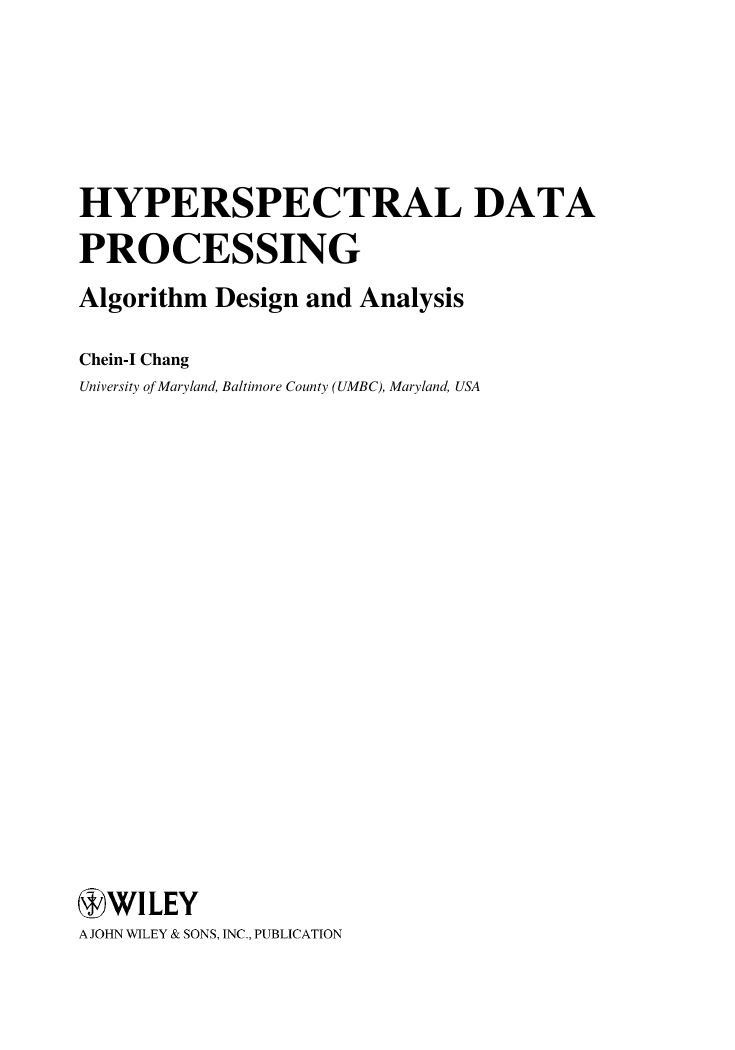


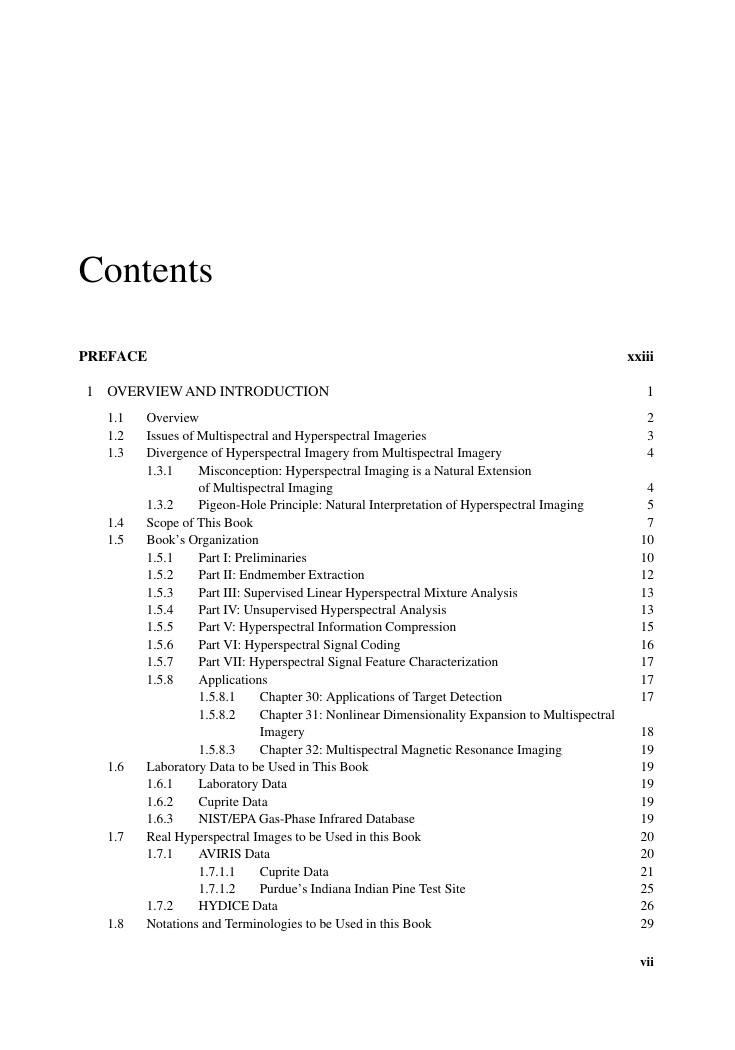
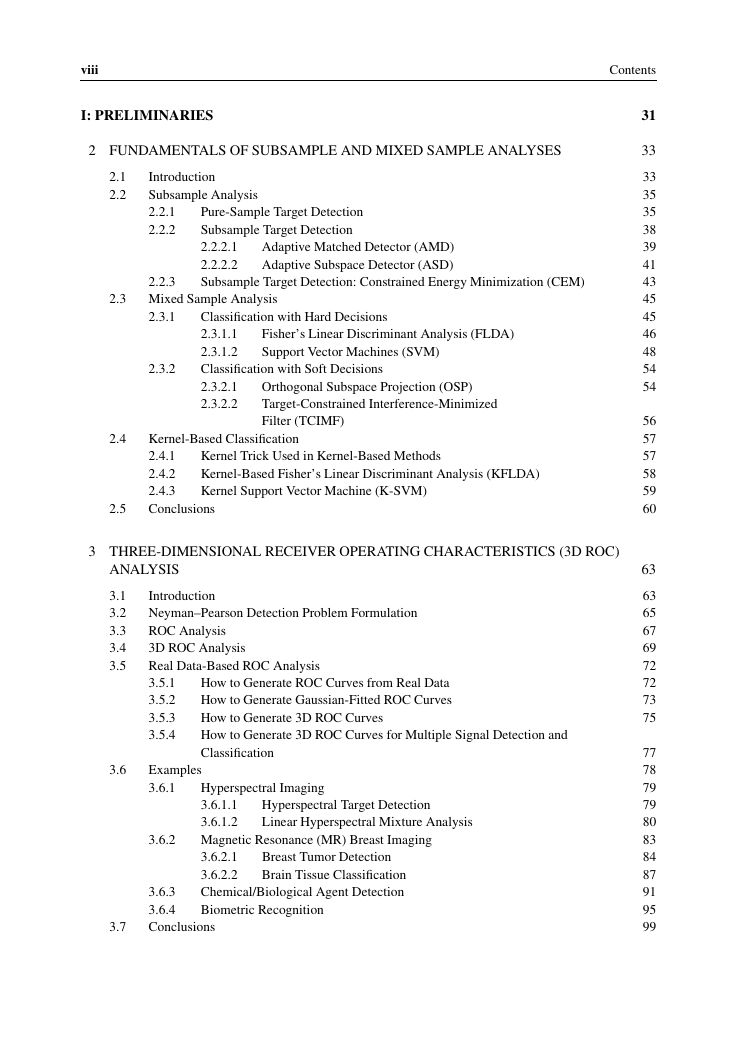
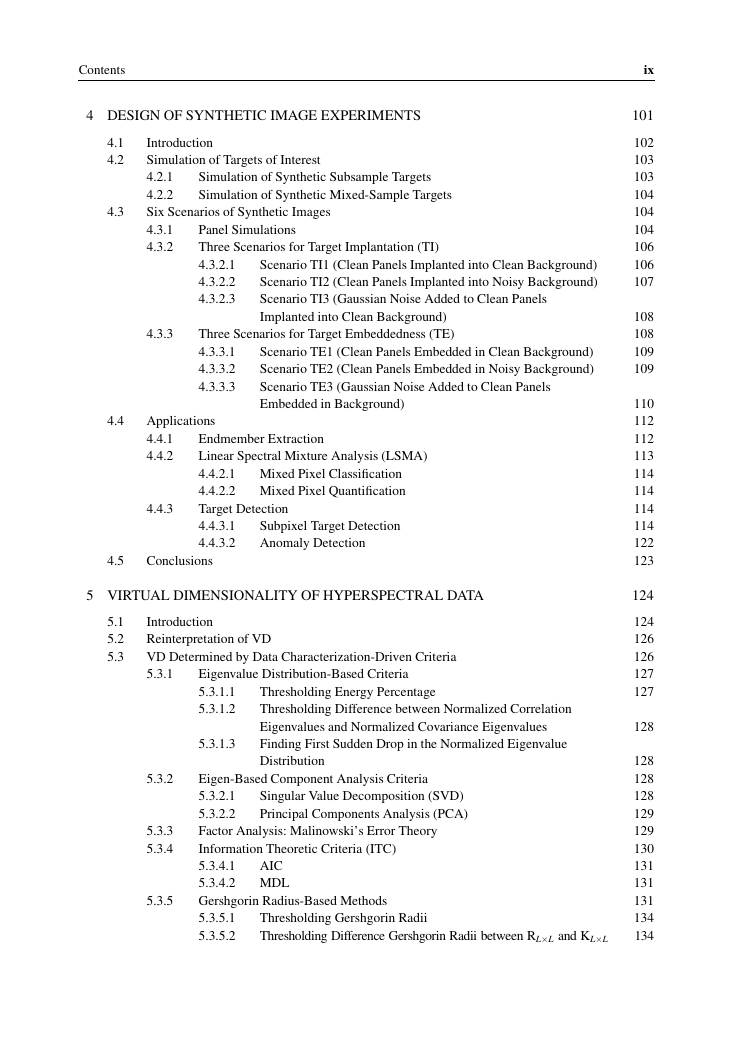
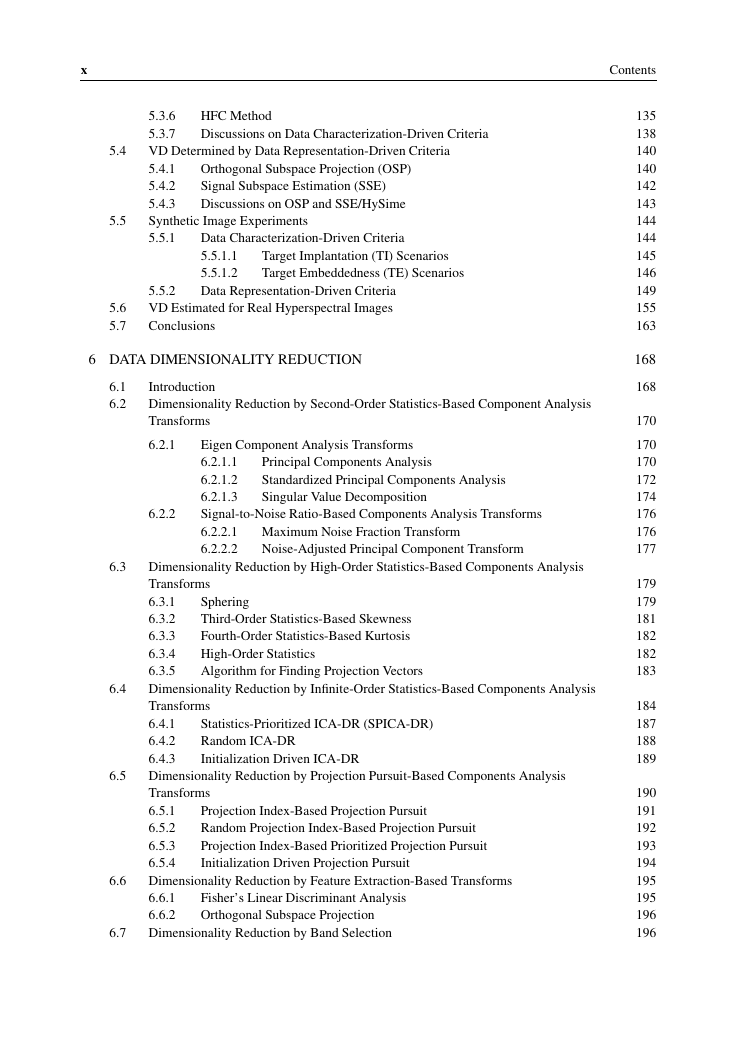








 2023年江西萍乡中考道德与法治真题及答案.doc
2023年江西萍乡中考道德与法治真题及答案.doc 2012年重庆南川中考生物真题及答案.doc
2012年重庆南川中考生物真题及答案.doc 2013年江西师范大学地理学综合及文艺理论基础考研真题.doc
2013年江西师范大学地理学综合及文艺理论基础考研真题.doc 2020年四川甘孜小升初语文真题及答案I卷.doc
2020年四川甘孜小升初语文真题及答案I卷.doc 2020年注册岩土工程师专业基础考试真题及答案.doc
2020年注册岩土工程师专业基础考试真题及答案.doc 2023-2024学年福建省厦门市九年级上学期数学月考试题及答案.doc
2023-2024学年福建省厦门市九年级上学期数学月考试题及答案.doc 2021-2022学年辽宁省沈阳市大东区九年级上学期语文期末试题及答案.doc
2021-2022学年辽宁省沈阳市大东区九年级上学期语文期末试题及答案.doc 2022-2023学年北京东城区初三第一学期物理期末试卷及答案.doc
2022-2023学年北京东城区初三第一学期物理期末试卷及答案.doc 2018上半年江西教师资格初中地理学科知识与教学能力真题及答案.doc
2018上半年江西教师资格初中地理学科知识与教学能力真题及答案.doc 2012年河北国家公务员申论考试真题及答案-省级.doc
2012年河北国家公务员申论考试真题及答案-省级.doc 2020-2021学年江苏省扬州市江都区邵樊片九年级上学期数学第一次质量检测试题及答案.doc
2020-2021学年江苏省扬州市江都区邵樊片九年级上学期数学第一次质量检测试题及答案.doc 2022下半年黑龙江教师资格证中学综合素质真题及答案.doc
2022下半年黑龙江教师资格证中学综合素质真题及答案.doc